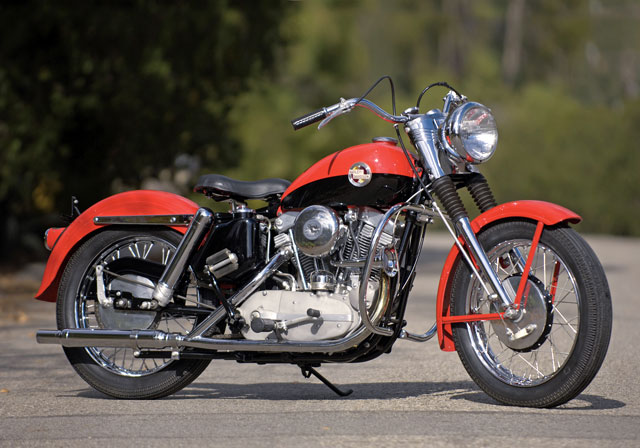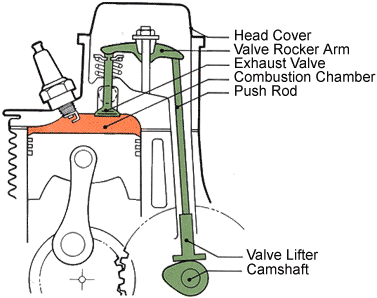
Harley Davidson Sportster history
The Sportster is a line of motorcycles produced continuously since 1957 by the Harley Davidson motor company. Sportster models are designated in Harley-Davidson’s product code by beginning with “XL”. In 1952, the predecessors to the Sportster, the Model K Sport and Sport Solo motorcycles, were introduced. These models K, KK, KH, and KHK of 1952 to 1956 had a flat head engine, whereas the later XL Sportster models use an overhead valve engine. The first Sportster in 1957 featured many of the same details of the KH including the frame, fenders, large gas tank and front suspension.
 Flathead engine
Flathead engine

Overhead-valve engine
Construction
Sportster motorcycles are powered by a four-stroke, 45 degree V-twin engine in which both connecting rods, of the “fork and blade” or “knife & fork” design, share a common crank pin.
The original Sportster engine was the Ironhead engine, which was replaced with the Evolution engine in 1986. Sportster engines, the 45″ R, D, G & W Models 1929 side-valve motors, and the ‘Big Twin’ side-valve motors, which were: the flathead 74 cu in (1,213 cc) Models V, VL etc. (1930–1936), Models U and UL (1937–1948), and the 80 cu in (1,311 cc) models VH and VLH (1935–1936), models UH and ULH (1937–1941) have four separate cams, sporting one lobe per cam.
The cam followers used in Sportster engines, K models, big twin side valve models, and the side-valve W model series were a slightly shorter version of the followers used in the larger motors, but with the same 0.731-inch (19 mm) diameter body and 0.855-inch (22 mm) diameter roller follower since 1929. The company used similar cam followers for decades with minor changes, from the 1929 to the Eighties.

Harley Davidson XL Sportster 1960 – 883 cc of Vietnam traffice policeman
The engine was mounted directly to the frame from 1957 through the 2003 model year. While this system allows the bike to be somewhat lighter with more precise handling, it also transmits engine vibration directly to the rider. Sportsters released in 2004 and later use rubber isolation mounts and tie links to limit engine movement to a single plane, which greatly reduces vibration felt by the rider. Buell motorcycles built with variants of the Sportster engine have used a rubber mount system since 1987.
The Model K, from which the Sportster evolved, was the first civilian motorcycle produced by Harley-Davidson with hydraulic shock absorbers on both wheels. Common usage calls this a K Model.
Model K series

This is developed from the earlier 45 W model, but with the revised flat head engine and new 4-speed transmission contained in the same castings as would become the Sportster. The connecting rods would be inherited by the Sportster along with many other design features and dimensions.
- Model K and KK 1952–1953: 750 cc side-valve engines, using the 45 model bore and stroke of 2.75″ x 3.8125″ (69.85 x 96.85 mm)
- Model KR (racing only) 1953–1969: 750 cc side-valve engines
- Model KH and KHK 1954–1956: 888 cc side-valve engines, using the 45 model bore, but with the stroke increased to 4.5625″ (115.89 mm). This is the only small twin with a longer stroke than 3.8125″. The shorter stroke is otherwise universal to the entire 45/K/Sportster line from 1929 to the present (exception: XR750, XB9 Buell).
XL series Sportsters

- XL, Ironhead, 1957–1985: 883 cc and 1,000 cc Ironhead overhead-valve engines with cast iron heads, K series frame
- XLCH, Ironhead, (unofficial “Competition Hot” moniker) 1958–1971: 883 cc, and 1,000 cc 1972 & up
- XR-750 (racing with the exception of being Evel Knievel’s jump bike while sponsored by Harley-Davidson between 1970 and 1977) 1970–1971: 750 cc overhead-valve engine, iron heads
- XR-750 (racing only with the exception noted above) 1972–1985: 750 cc overhead-valve engine, alloy heads
- XLCR 1977–1978-1979: Cafe racer 1,000 cc overhead-valve engine, iron heads, 2000 made in 77, 1200 in 78, and 9 in 1979
- XR-1000 1983–1984: 1,000 cc street model using XR racing cylinder head and other XR engine parts
- XLR: 883 cc overhead-valve engines, iron heads
XLS Roadster 1982 — 1000cc ironhead / 4 speed, stock features — 2″ longer forks, 2 up seat, sissy bar, highway pegs, 3.5 gallon “Superglide” tank
- XLS Roadster, 1983-1985, 1,000 cc ironhead, 4 gallon fuel tank with console
- XL, Evolution (also known as the “Evo”), since 1986: 883 cc, 1,100 cc and 1,200 cc Evolution overhead-valve engine, alloy heads
Source: harley-davidson.com
